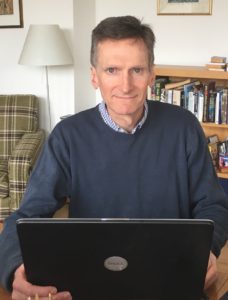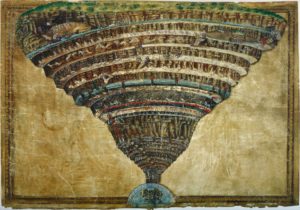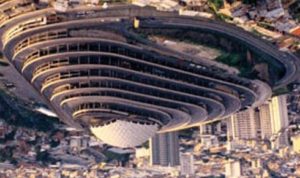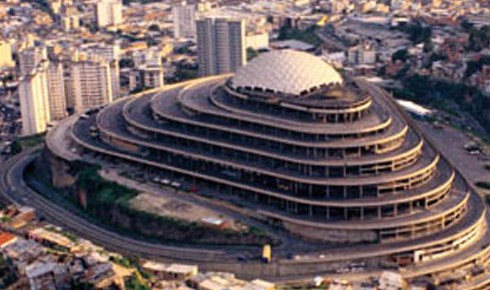14 March 2019
El Helicoide
Hell in Caracas.
By Neil Tidmarsh
 The massive and futuristic El Helicoide centre in Caracas was designed and built as a shopping mall – but it’s now the headquarters of Venezuela’s security service and intelligence agency SEBIN (the Bolivarian National Intelligence Service).
The massive and futuristic El Helicoide centre in Caracas was designed and built as a shopping mall – but it’s now the headquarters of Venezuela’s security service and intelligence agency SEBIN (the Bolivarian National Intelligence Service).
What a perfect metaphor for the failure of a socialist revolution.
Shopping malls are the cathedrals of capitalism. They’d be obvious and natural targets for violent far-left insurrectionists. Who wouldn’t be tempted to cheer “Viva la revolución!” as socialist iconoclasts silenced the piped muzac, threw out the cash-machines, liberated the exploited minimum-wage workers and the enslaved consumers, bulldozed the tawdry architecture, smashed the plate glass and tore down the cheap lies, empty illusions and cruel temptations of the window-displays? Who wouldn’t echo Wordsworth’s fanfare for the French Revolution (“Bliss was it in that dawn to be alive / But to be young was very heaven!”) as groups of bored and listless teenagers stumbled out of the air-conditioned desert where they’d been wasting their time for so long, sniffed the fresh air and beheld a brave new world which would give them better things to do with their lives?
And then – the shopping mall once conquered – what to replace it with? What to use the building for, now it’s no longer a capitalist, materialist, consumerist trap? Something for the people, of course. A park, perhaps, or a library. Or a free hospital. Or a school. Or a university for all. Or a concert hall. Or a theatre. Or a community centre. Or social housing…
But not, dear god of dialectics, please, no, not a base for the new regime’s terrifying and oppressive security forces, a centre for the secret police and spies tasked with keeping an eye on the country’s citizens, a prison for all those citizens brave or foolish enough to criticise or oppose the regime, a work-place for the president’s torturers…
El Helicoide was destined to be more than just a building – but an icon, a symbol, a metaphor – from the very beginning. It was designed sixty years ago as the world’s first drive-through shopping centre, a huge three-sided pyramid with four kilometres of road wrapped around it, spiralling up on seven levels. It was to have 300 shops, eight cinemas, a five-star hotel, a private club, parking for every shopper, a heliport and a palatial penthouse on the seventh floor. It was to be a shopping mall like no other, a space-age gesture, a sign to the rest of the world that Venezuela was a modern, confident, rich and dynamic country in a world-beating continent.
Construction began in 1956. Many poor families were evicted from the area and their homes were demolished to make way for it. Over the next twenty years, however, little more than the building’s concrete skeleton was completed. Military dictatorships, coup d’etats, revolutions, economic boom and bust, litigation and bankruptcies ground the project down and brought it to a halt. Material, goods and equipment were stolen or disappeared. It became a different kind of symbol – a symbol of Latin America’s political instability, inefficiency, corruption and ‘magic realism’ fantasy.
In the late 1970’s it was bought by the government. Thousands of squatters, made homeless by landslides in nearby towns, came and went. The place became a centre for drug-dealing, prostitution and crime. But construction picked up and ten years later various government departments – police, intelligence and security – began to move into its newly-created spaces; offices on the top floors and prisons on the bottom floors.
These days it’s occupied by SEBIN. “Its crumbling concrete shell houses the headquarters of Venezuela’s intelligence services and the country’s most notorious political prison” Emma Graham-Harrison recently wrote in The Guardian. “It has become a symbol of national decay, bankrupt dreams and faltering democracy… the building can still be seen from around the capital, and casts a long shadow of fear”. Her report, and reports by Karenina Velandia and Charlie Newland for the BBC, detail allegations (from former prisoners, their families, lawyers, NGOs and even former guards) of the mass arrests of protesters, demonstrators and activists, of illegal detentions, of over-crowding and physical and psychological brutality, of torture and other horrors. Its transformation from utopian dream to dystopian nightmare is now complete. Detainees are being driven in by the busload; the prisons are full to bursting; make-shift cells are being knocked up out of cupboards, store-rooms and even toilets. It’s clearly now a symbol of a system on the verge of inevitable collapse.
The name El Helicoide refers to its ‘helicoid’ shape, but its punning association with ‘hell’ (in English, at least) is most apt. The Spanish word for hell is ‘infierno’ and the pyramid of El Helicoide with its spiralled terraces does indeed look – alarmingly and amazingly – just like those medieval Italian pictures of the nine circles of hell in Dante’s Inferno.
A shopping mall is many people’s idea of hell; but El Helicoide reminds us that there are many worse and deeper circles to infierno. One wonders just how long it will be before Maduro’s regime is finally banished to them.




